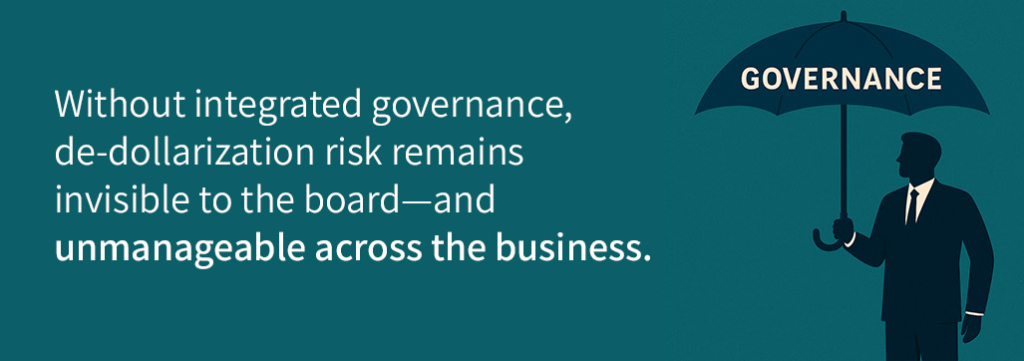De-Dollarization: What Leading Organizations Are Doing Right Now
By Steven Minsky, CEO of LogicManager
Last Updated: June 10, 2025
Lately, a growing number of executives have asked me how to prepare for global currency shifts — and specifically, de-dollarization. The concern isn't new, but it's gaining urgency—currency fluctuations, vendor instability, procurement changes—so they want to know: What should we be doing now that's manageable, realistic, and won't create more operational burden?
Here's what I'm telling them:
Many LogicManager customers are already using their ERM programs to do just that. Quietly, they've built the operational governance necessary to detect early signals, map dependencies, and ensure risk-based processes adapt automatically as conditions evolve. They're not reacting to headlines. They're using Risk Ripple automation, visibility rules, and workflows to detect and manage change before it spreads—and when it does, they're ready.
Here's what I'm advising organizations to put in place and what many of our customers have already operationalized.
1. Map Currency Exposure to Business Operations
The first step is visibility, encompassing not only financial exposure but also operational touchpoints across suppliers, contracts, and internal processes. Many customers have proactively tagged procurement processes, contracts, payment terms, and supplier obligations by both currency and geography.
This enables real-time visibility into where currency fluctuations may affect pricing, sourcing, or financial obligations. When conditions shift — for example, when a vendor requests contract renegotiation due to exchange rate volatility — Risk Ripple workflows automatically surface every impacted process, system, and owner.
The result: affected areas are identified immediately, and decision-makers have clear, actionable intelligence — without the need for manual tracing across spreadsheets and departments.
2. Monitor Third-Party Concentration Risk Systematically
Currency shifts don't operate in isolation. Vendor concentration amplifies exposure, especially when suppliers operate within jurisdictions or currencies under stress.
Using LogicManager's Third-Party Risk Packages, organizations automatically flag when a single vendor supports multiple critical functions. If a disruption or change request is logged, Risk Ripple logic maps the exposure across the entire Risk Wheel — linking vendors to associated controls, assessments, contracts, and dependencies. This allows leadership to understand not just who the vendor is, but where the risk propagates operationally.
3. Maintain System and Ownership Integrity as Conditions Change
Global disruptions often trigger organizational adjustments: role changes, new ownership structures, revised oversight responsibilities. Without continuous governance, these shifts create gaps in accountability precisely when oversight is most critical.
Through LogicManager's SCIM-enabled Connector Program, organizations maintain an active inventory of critical systems, applications, and responsible owners. Changes in organizational structure are automatically reflected in system ownership, access privileges, and compliance workflows. This ensures governance remains current — even as personnel or organizational structures evolve.

4. Implement Scenario-Based ERM Plans With Embedded Accountability
Scenario plans are often treated as static exercises, disconnected from operational execution. In practice, the most effective plans are dynamic and directly tied to real business processes.
Many LogicManager customers have built scenario-based ERM Plans that activate automatically when specific triggers occur: supplier payment disruptions, contract renegotiations, or shifts in credit terms. These plans are tied to responsible owners, defined controls, and risk monitoring activities. As the risk level adjusts, Risk Ripple propagation updates all downstream workflows automatically, ensuring activities remain aligned without requiring ad hoc intervention.
5. Deploy Early Warning Indicators Linked to Automated Workflows
The earliest signs of currency instability rarely arrive as major events. Instead, they present as incremental changes: unexpected contract clauses, delayed shipments, additional conversion fees. Organizations must monitor for these signals continuously.
Risk Indicators allow customers to define thresholds that trigger automated workflows as soon as conditions warrant review. Once a threshold is crossed, LogicManager initiates the appropriate workflows, updates impacted assessments, and, where needed, integrates with external systems for coordinated response — all without manual handoffs.
The Broader Lesson: Governance, Not Prediction, Is the Priority
The global financial system is evolving. Whether de-dollarization progresses gradually or accelerates in response to geopolitical catalysts is ultimately not the most important variable. The question is whether your organization has a risk governance framework capable of identifying early signals, mapping dependencies, and executing pre-defined responses before exposure compounds.
What I'm telling customers is simple: you already have what they need to stay ahead. You don't need new committees, new teams, or massive new projects. You need to activate the governance capabilities you already have — connecting risks across the business, automating ownership, and making decisions before problems compound.
This is not a matter of speculative forecasting. It is a matter of disciplined execution.
If your organization is uncertain where to begin, the first step is not to build new committees or develop complex scenario models. The first step is to activate the governance structures that connect risks to operations, ensuring that when change occurs, you are prepared to act on it systemically, not react to it episodically. That's what risk-based governance delivers. And that's exactly what LogicManager users are already doing today.
